An 11-year-old boy with a febrile illness
An 11-year-old boy was admitted to the pediatric ward in the month of June with a febrile illness and a rash with concern for meningococcemia.
The history of this illness began three days prior to admission with the onset of fever to 102° F, loss of appetite and malaise. The child continued to have fever and feel bad through the next three days, developing a petechial rash, mixed with maculopapular lesions, headache and conjunctivitis the day before admission. There were no other symptoms, such as nausea, vomiting, coughing or pain other than the headache and itching/aching eyes.

Pediatric Infectious Disease, Scott and White's Children's Health Center and Associate Professor of Pediatrics,
Texas A&M University, College of Medicine, Temple, Texas.
e-mail: jhbrien@aol.com
His past medical history is positive for recurrent otitis media when younger, necessitating tubes. He has also been admitted several times with asthma and once with a renal stone. His last illness was about a week earlier when he had a minor febrile episode that lasted less than 48 hours.
His immunizations are up to date. He has some known allergies to shrimp and airborne allergens per his allergist. He has had no known sick contacts, but did get exposed to some poison ivy while hiking just prior to the onset of this illness. There is no known heavy metal exposure, but his father is employed as a truck driver, who may periodically transport unknown toxic materials.
His family and social history is positive for living in a rural environment, using well water and exposure to farm animals.
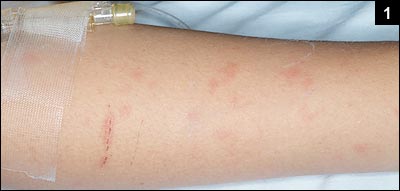


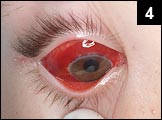
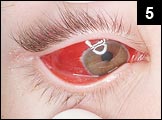
Examination on admission revealed normal vital signs, a normal-appearing, alert and oriented 11-year-old complaining of headache and painful eyes. The only positive findings were the generalized rash as described above, sparing the palms and soles and marked erythema of his eyes as shown in figures 1 – 5.
A sepsis work up (blood, urine, spinal fluid and chest radiograph) was performed in the emergency department, with cultures pending. All preliminary results were normal. Doses of ceftriaxone and vancomycin were given and he was placed in isolation (droplet precautions) prior to admission.
What’s your diagnosis?
- Mercury Poisoning
- Meningococcemia
- Enterovirus Infection
- Rhus Dermatitis
Answer
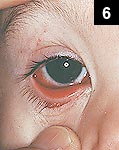
This patient has hemorrhagic conjunctivitis with a rash consistent with the viral exanthema of an enterovirus infection (answer C), which also fits the biphasic nature of his illness and time of year (summer).
All his bacterial cultures were negative, as was a viral culture of his eye. Nowadays we would perform a PCR (polymerase chain reaction) for enterovirus, which might increase our chances of identification. Nonetheless, the infectious diseases consultant recommended stopping the antibiotics and enforcing contact precautions rather than droplet isolation precautions. A similar illness might be seen with adenovirus infections (figure 6), just not as likely as enterovirus. The patient was soon discharged home to make an uneventful recovery without any specific therapy.
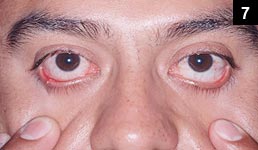

The possibility of meningococcemia was the primary reason the patient was admitted. However, as scary as this might be, there were a few clues against this diagnosis. Although the rash might be consistent early on, hemorrhagic conjunctivitis is not part of the usual clinical picture of meningococcemia. At least a couple of studies have provided evidence that when a patient has a petechial rash, particularly when predominantly confined to the upper body, with a febrile illness that is clinically consistent with a viral infection, the chances of meningococcemia are markedly reduced. The patient in figure 7 was admitted with a febrile illness and a petechial rash on her face, and her father had bilateral conjunctivitis (figure 8). They both turned out to have adenoviral infections. However, in the early phase of the evaluation, it is certainly appropriate to assume and treat for the worst case until the clinical picture becomes clearer.
Mercury poisoning, which is fairly uncommon these days, can certainly cause a rash that is highly pruritic, particularly of the extremities, accompanied by pain (acrodynia) with subsequent desquamation of the palms and soles (figure 9). These patients usually also demonstrate neurological abnormalities such as fasciculations and seizures, requiring chelation therapy.
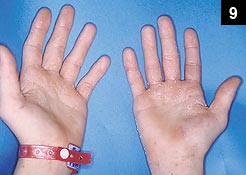
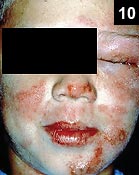
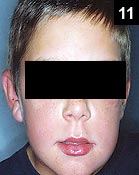
Lastly, rhus dermatitis, a rash caused by contact with the oil, urushiol, produced by a member of the Rhus genus (usually poison ivy). It can be minor or fairly severe, misleading the provider into thinking the patient has a severe cellulitis, as shown in figure 10, a patient admitted from the ED with presumed preseptal and facial cellulitis. That patient did well with a brief course of systemic steroids and topical therapy with wet dressings, as shown several days later in figure 11. Rhus dermatitis will usually last one to three weeks, depending on the severity and therapy chosen. With summer well underway, you can expect to see this problem in children fortunate enough to be able to get out in the great outdoors.
Columnist comments
We have been experiencing a very active enterovirus season this summer, including many more cases of aseptic meningitis than we usually see.
Many of these patients have also had rashes like that presented above, and some with conjunctivitis, although not as dramatic as the patient presented. Nowadays, with an excellent PCR lab, we can confirm the diagnosis of enteroviral aseptic meningitis within hours of the lumbar puncture (LP). This has allowed many, less ill patients to be followed as outpatients, avoiding admission altogether. In the “good old days,” before we had such sophisticated viral detection capability, we admitted almost all of these patients and would frequently do repeat spinal fluid analysis to look for the characteristic shift of the white blood cells from a predominance of granulocytes on the first LP to a predominance of lymphocytes on the second, 12 to 24 hours later, to be confident of the aseptic meningitis diagnosis. Otherwise, we waited for the culture results 48 to 72 hours later before discharging. Now we just need a way to avoid the need for an LP in the first place (I was just interrupted by one of our senior residents calling from the ED about a 17-day-old, from whom no one could obtain CSF). Oh well.
Please keep in touch, and let me know your thoughts regarding topics you might like to see featured in this column. Till then, stay cool.
What’s Your Diagnosis? is a monthly case study featured in Infectious Diseases in Children, with treatment information and discussion to follow.
